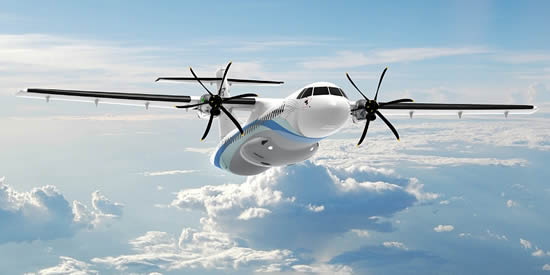| ATR beat all previous sales,
delivery, turnover and backlog records in 2014. The aircraft manufacturer's sales increased to 160 aircraft, along with 120 options, exceeding the previous 2011 record (157 firm sales and 79 options).
ATR also achieved a record turnover in 2014, reaching 1.8bn dollars (1.63bn in 2013), and increased its deliveries to 83 aircraft (compared with 74 in 2013). As a result of an extraordinary commercial year, ATR ended 2014 with an unprecedented 280 aircraft in its backlog.
During the year the company signed the largest cumulative order of its history, with a contract that brings the number of firm aircraft orders from the Indonesian airline Lion Air to one hundred. ATR also reached a major milestone in its history with the signing of the 1000th order for the ATR 72 which will fly the flag of Airlines PNG, the Papua New Guinea airline.
 |
|
ATR
72-600 |
The 160 firm sales and 120 options represent nearly half the total sales of regional aircraft of below 90-seat capacity for the year. It reinforces the position of the ATR-600 as the regional aircraft of choice of airlines and leasing companies across the world. For the turboprop aircraft segment, these sales account for 80% of all the orders for the year.
The 83 deliveries in 2014 represent not only a new record for ATR but also an increase of more than 60% over the last five years (51 deliveries in 2010). This number of deliveries, which ranks first among all below-90-seat regional aircraft deliveries during the last year, enables ATR to pursue one of its main lines of development, namely the consolidation of its production ramp-up which will continue in 2015 and should enable it to exceed the 100 deliveries mark in 2016.
In 2014 ATR registered a new record turnover of 1.8bn dollars. This financial performance will continue its upward trend in 2015, to tend to the ambitious figure of 2bn dollars, due notably to the even higher delivery forecasts.
Since the start of the program in 1981, ATR has registered net orders for 1470 aircraft (470 ATR 42s and 1000 ATR 72s).
As at 31 December 2014, ATR had delivered 1190 aircraft (436 ATR 42s and 754 ATR 72s). These figures enable ATR to boast a new record: a backlog of 280 aircraft at the start of the year. The order book represents a value of 6.8bn dollars, and means that ATR can guarantee nearly three years of production while continuing to increase its delivery rates.
Patrick de
Castelbajac, Chief Executive Officer of ATR, is “delighted with ATR's excellent performance in 2014. Our aircraft are the undisputed world reference among regional airlines and aircraft leasing companies. Whether for their low operating costs, their reliability and versatility, or their small environmental footprint and value retention over time, ATRs today are the preferred aircraft of short-haul network operators. We continue to increase our production rates, develop our aircraft and expand our global footprint across the world with the aim of better serving our customers.”
Moreover, with a view to creating ever-closer ties with its operators, ATR continued to build its presence across the world in 2014 by establishing new partnerships for pilot training in Bangkok and Bogota. ATR has also signed new maintenance contracts with the result that as of today, nearly two ATR -600s out of three in service are covered by this type of agreement with the manufacturer. ATR will continue to develop its global network in 2015 with the opening of a sales representation office in Tokyo and a new spare parts center in Sao Paulo.
With regard to the ATR -600s, the latest members of its aircraft family, ATR continued to equip them with the most advanced technological innovations in 2014 so that they always remain at the cutting edge of modernity, performance and reliability. A new engine - the PW127N - has been certified, bringing with it 4.5% additional take-off power and thereby increasing aircraft performance in hot weather and at altitude. Furthermore, new functions have been developed for the ATR -600s' avionics, enabling them to follow more precise and even-safer approach flight paths thanks to satellite navigation, without the need for ground-based navigation aids and significantly reducing pilot workload. |